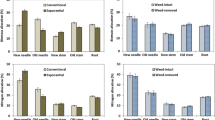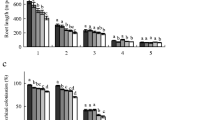Summary
Lodgepole pine (Pinus contorta Dougl.), Engelmann spruce (Picea engelmanni Parry), and Douglas-fir (Pseudotsuga menziesii (Mirb.) Franco) seedlings were grown in open-ended tube cultures of sand and perlite, irrigated with nitrate, ammonium, and a 1∶1 mixture of ammonium and nitrate, combined factorially with pH values of 4.6, 5.3 and 6.0 giving a total of nine treatments. Douglas-fir showed intolerance to ammonium which was especially marked in root weight. Lodgepole pine and Engelmann spruce made poor growth with nitrate, but showed little difference between ammonium and mixed sources. Only Douglas-fir showed a significant response to pH treatments with pH 5.3 plants being largest. Contamination of the sand with carbonate-bicarbonate, apparently caused seedlings grown in ammonium solutions to be larger in sand than in perlite.
Douglas-fir grown in perlite cultures showed a growth response like the first experiment and nitrate reductase activity in the order nitrate > nitrateammonium mixture > ammonium. Plastic bead cultures had poor growth response due to low retention of water by the substrate, but the nitrate reductase assays produced results like the perlite cultures.
Lodgepole pine grown in water culture demonstrated the well known pH shift associated with different nitrogen forms, and when assayed for nitrate reductase these seedlings had larger relative activities than Douglas-fir, but the order of activity remained nitrate > mixed source > ammonium.
Similar content being viewed by others
References
Afridi, M. M. R. K. and Hewitt, E. J., Induction and stability of nitrate reductase in tissues of higher plants. Life Sci.7, 287–295 (1962).
Barker, A. V., Volk, R. J. and Jackson, W. A., Growth and nitrogen distribution patterns in bean plants (Phaseolus vulgaris L.) subjected to ammonium nutrition: I. Effects of carbonates and acidity control. Soil Sci. Soc. Am. Proc.30, 228–232 (1966).
Cain, John C., A comparison of ammonium and nitrate nitrogen for blueberries. Am. Soc. Hort. Sci. Proc.59, 161–166 (1952).
Cox, W. J. and Reisenauer, H. M., Growth and ion uptake by wheat supplied nitrogen as nitrate, or ammonium, or both. Plant and Soil38, 363–380 (1973).
Gomori, G., Preparation of buffers for use in enzyme studies Vol.1, p. 138–146.In Methods in Enzymology. Academic Press Inc., New York (1955).
Hacskaylo, John, Finn, R. F. and Vimmerstedt, J. P., Deficiency symptoms of some forest trees. Ohio Agricultural Research and Developmental Center, Research Bulletin 1015 (1969).
Havill, D. C., Lee, J. A. and Stewart, G. R., Nitrate utilization by species from acidic and calcareous soils. New Phytol.73, 1221–1231 (1974).
Kirkby, E. A., Ion uptake and ionic balance in plants in relation to the form of nitrogen, p. 215–235.In I. H. Rorison (Ed.). Ecological aspects of the mineral nutrition of plants. Blackwell Scientific Publications, Oxford and Edinburgh (1968).
Krajina, V. J., Ecology of forest trees in British Columbia. Ecology of Western North America. 2. 1–146. Botany Department, University of British Columbia(1969).
Krajina, V. J., Madoc-Jones, S. and Mellor, G., Ammonium and nitrate in the nitrogen economy of some conifers growing in Douglas-fir communities of the Pacific North-West of America. Soil Biol. Biochem.5, 143–147 (1973).
Li, C. Y., Lu, K. C., Trappe, J. M. and Bollen, W. B., Nitrate-reducing capacity of roots and nodules ofAlnus rubra and roots ofPseudotsuga menziesii. Plant and Soil37, 409–414 (1972).
Maynard, D. N. and Barker, Allen V., Studies on the tolerance of plants to ammonium nutrition. J. Am. Soc. Hortic. Sci.94, 235–239 (1969).
Mulder, E. G., Boxma, R. and Van Veen, W. L., The effect of molybdenum and nitrogen deficiencies on nitrate reduction in plant tissues. Plant and Soil10, 335–355 (1969).
McFee, W. W. and Stone, Jr. E. L., Ammonium and nitrate as nitrogen sources forPinus radiata andPicea glauca. Soil Sci. Soc. Am. Proc.32, 879–884 (1968).
Shinn, M. B., Colorimetric method for determination of nitrate. Ind. Eng. Chem.13, 33–35 (1941).
Stevens, D. L. and Oaks, A., The influence of nitrate on the induction of nitrate reductase in maize roots. Can. J. Bot.51, 1255–1258 (1973).
Swan, H. S. D., The mineral nutrition of Canadian pulpwood species. I. The influcnce of nitrogen, phosphorus, potassium and magnesium deficiencies on the growth and development of white spruce, black spruce, jack pine and western hemlock seedlings grown in a controlled environment. Pulp and Paper Res. Inst. of Canada (Montreal) Tech. Rep.168; Woodlands Research Index No. 116, p. 66 (1960).
Townsend, L. R., Effects of nitrate and ammonium nitrogen on the growth of the lowbush blueberry. Can. J. Plant Sci.46, 209–210 (1966).
Townsend, L. R., Effect of ammonium and nitrate nitrogen, separately and in combination, on the growth of highbush blueberry. Can. J. Plant Sci.47, 555–562 (1967).
Townsend, L. R., Influence of form of nitrogen and pH on growth and nutrient levels in the leaves and roots of the lowbush blueberry. Can. J. Plant Sci.49, 333–338 (1969).
Van den Driessche, R., Response of conifer seedlings to nitrate and ammonium sources of nitrogen. Plant and Soil34, 421–439 (1971).
Van den Driessche, R. and Dangerfield, J., Response of Douglas-fir seedlings to nitrate and ammonium nitrogen sources under various environmental conditions. Plant and Soil42, 685–702 (1975).
Zinkan, C. G., Jeglum, J. K. and Harvey, D. E., Oxygen in water culture influences growth and nutrient uptake of jack Pine, black Spruce and white Spruce seedlings. Can. J. Plant Sci.54, 553–558 (1974).
Author information
Authors and Affiliations
Rights and permissions
About this article
Cite this article
Bigg, W.L., Daniel, T.W. Effects of nitrate, ammonium and pH on the growth of conifer seedlings and their production of nitrate reductase. Plant Soil 50, 371–385 (1978). https://doi.org/10.1007/BF02107186
Received:
Issue Date:
DOI: https://doi.org/10.1007/BF02107186




